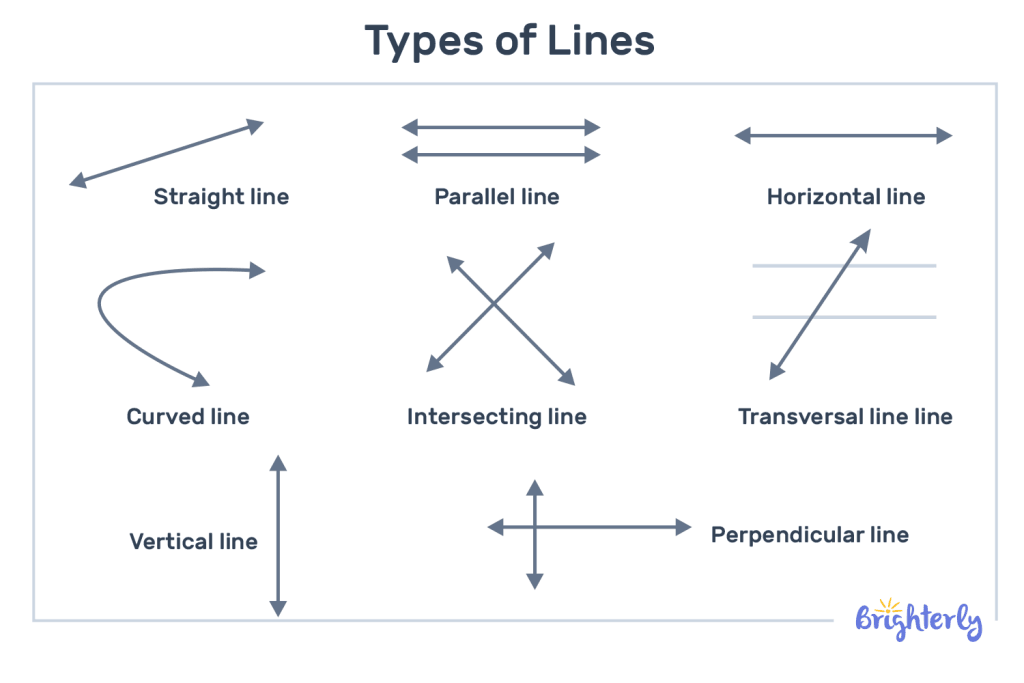Types of Lines – Definition With Examples
reviewed by Florence Khitsane
Updated on October 28, 2025
This informative piece of knowledge developed by Brighterly will help you explore all the different lines types you’ll encounter in math, from curved and straight lines to parallel and perpendicular lines, and provide some examples of line types. We’ll also cover the definition of a line and share practice problems so you can test out your new knowledge.
What is a line?
So, what are lines? In math, it’s a one-dimensional object that extends infinitely in two directions. Lines have no width, depth, or endpoints. Understanding lines will be key to your understanding of geometry.

Difference between line and line segment
The difference between lines and line segments is that lines have no endpoints, but line segments have two defined endpoints. A line segment can be a portion of a line and has a specific measurement.
Difference between line and ray
The difference between a line and a ray is that a line extends infinitely in two directions. A ray, by contrast, only extends infinitely in one direction. Unlike a line, a ray has a defined start point, but no endpoint.
What are the types of lines in geometry?
There are lots of different kinds of lines in geometry, which you’ll see discussed below in detail, including examples of lines. You’ll also start to understand how to define lines – from whether they’re curved or straight to whether they intersect or not.
If you want to hone your skills in identifying and working with lines, check out our lines worksheets:
Lines of Symmetry Worksheets
Points Lines and Planes Worksheets
Points Lines and Planes Worksheets
a) Curved lines
A curved line is a line that curves at one or many points. An easy way to remember this type is by imagining them as circles and ovals (the shapes that are always made of curved lines).
Everyday examples: soccer balls, plates, and cups.
b) Straight lines
Straight lines are one of the types of lines in math that do not curve or bend. Straight lines can have any slope, meaning they can be horizontal, vertical, or diagonal. They are used to compose shapes, like squares, triangles, and rectangles.
Everyday examples: pieces of paper, the sides of TVs, and tables.
c) Horizontal lines
Horizontal lines are a type of lines that is straight and runs from left to right. They don’t slope, and are parallel to the horizon or the bottom of a page or screen.
Everyday examples: the floor in our homes, the tops of tables, and of course, the horizon itself!
d) Vertical lines
Vertical lines are lines that run up and down. These lines also don’t slope, and are parallel to the sides of a page or screen.
Everyday examples: lampposts, sides of buildings, and the legs of tables.
e) Parallel lines
Parallel lines are two or more straight lines that will never meet (aka intersect). This is because they are equally distant.
Everyday examples: sides of ladders, railroad tracks, and the stripes on road crossings.
f) Intersecting lines
Intersecting lines are different lines that will meet at a certain point, called the point of intersection. Intersecting lines can either meet at a point and stop, or they can cross one another.
Everyday examples: roads that cross one another, the hands on a clock, and pairs of scissors.
g) Perpendicular lines
Perpendicular lines are a type of intersecting line that meet at a 90° angle, also known as a right angle. These lines form a + shape or an L shape, like a corner.
Everyday examples: corners of tablet and phone screens, window corners, and door corners.
h) Transversal lines
Transversal lines are lines that cross at least two other lines. The other lines could be parallel to one another or intersecting one another.
Everyday examples: roads that intersect with more than two other roads, bridges with support beams, and grids on graphing paper.

Practice problems on types of lines
Here, you can test your current knowledge with some practice problems on different types of line. Simply write down your answers!
- What type of line can you find in a pair of scissors?
- You come to a road intersection that has roads in four different directions, intersecting in the middle at right angles. What types of lines are these roads?
- You have two lines that are an equal distance apart and on the same slope. Will these lines ever intersect?
Conclusion
Now you know everything there is to know about different types of lines! This knowledge builds the foundation of your skills in geometry and can help you solve more complex problems.
Equipped with this knowledge, you can identify all the different types of lines in your everyday life and in your math class!
Frequently asked questions on types of lines
What is line in geometry?
A line in geometry is a one-dimensional shape that continues infinitely in two directions – it has no start or endpoint. It also has no width or depth like 2D and 3D shapes have.
Why is it important to learn about lines in geometry?
It’s important to learn about lines in geometry because they are the simplest form of geometric shape. Plus, they are used to make up many other geometric shapes, too.
How many types of lines are there?
There are 8 main different types of lines. They are curved, straight, horizontal, vertical, parallel, intersecting, perpendicular, and transversal lines. These types are defined by their curvature, the direction they travel in, and whether or not they intersect other lines
What are the different types of lines?
The different type of lines are:
- Curved lines
- Straight lines
- Horizontal lines
- Vertical lines
- Parallel lines
- Intersecting lines
- Perpendicular lines
- Transversal lines
Are all straight lines also horizontal lines?
No, not all straight lines are horizontal lines. Straight lines can have a slope and point in any direction, whereas horizontal lines are parallel to the horizon and go from left to right. However, all horizontal lines are straight lines, meaning they do not curve.






